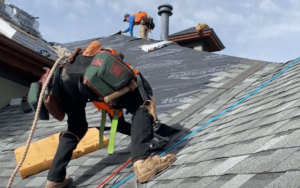Columbus GA Roofers can assess and determine the best course of action when repairing or installing a new roof. This skill, gross body equilibrium, and problem sensitivity are crucial to performing the job well.

Roofers typically have the Interest area of Building and the Organizing interest trait. They also have the Adaptability trait.
Residential roofers work on single- and multi-family homes and condos. They navigate through residential neighborhoods, climbing on rooftops to access different areas of a roof and perform the necessary repairs. These roofers may be insurance-focused, working directly with the insurance company to streamline the process and give the homeowner a lower bill. They also do typical roof replacements and offer zero-percent financing. They will usually have a salesperson who is onsite during the entire project, interfacing with the crew and answering any questions the client might have. These are typically larger companies. They may also have a specialized team that works on storm damage.
Commercial
As the name implies, commercial roofers work on roofs of commercial buildings. These roofs often have different materials than residential roofs and can be more complex to repair or replace. Commercial roofers also typically have more experience working on unusual roof shapes and may be able to offer more options for the customer.
In addition to repairing and replacing roofs, commercial roofers may install insulation, flashing, vents, and other accessories to the roof. They may also install finishing metal, such as drip edges and gutters. They can also work with flat roofing systems, including EPDM rubber, PVC, and hot taped systems, as well as standing seam, torch down, and shingle.
Roofers can work on a variety of types of buildings, including retail, office buildings, hospitals, and other large structures. They must be able to work in all weather conditions and can be expected to spend long periods of time on ladders or scaffolding. They must also be able to handle the physical demands of the job, such as climbing on steep slopes or walking in tight spaces.
Professional roofers can inspect the condition of a business’s roof and address any problems that could lead to water leakage or other damage. They have the skills and equipment to perform these repairs quickly and efficiently, minimizing downtime for the business. They also have the knowledge to ensure that the repairs are done correctly, preventing future problems and costly replacements.
Whether working on new construction or repairing existing roofs, commercial roofers must follow strict safety standards and adhere to OSHA regulations. They must also use various tools, including blow torches, hammers, shears, and a variety of roof rakes and staff-bristled brushes. They can also apply glazing, cement, or caulking to prevent leakage and rust. As they complete their work, they may level and smooth roof surfaces. They can also clean up the work zone and remove any debris or waste from the site. Many commercial clients have specific requirements when it comes to the type and quality of roof they want, and they will often ask several contractors for quotes before choosing a company to work with.
Industrial
Roofers in this specialty install, replace, and repair roofs on industrial buildings. These projects are typically larger and more complex than those on commercial or residential structures, and they require more specialized knowledge of roofing materials and techniques. These professionals also must adhere to strict safety protocols when working on rooftops.
Most industrial roofers start their careers with 2-4 years of on-the-job training, during which they learn the basics of roofing and build up to proficient skills. This allows them to take on more complex roofs and work independently from other members of their roofing crews. Many full-service roofers have in-house fabrication departments that allow them to design and produce their own custom sheet metal components, speeding up construction times and passing on cost savings to customers. Many states have regulated the roofing industry, requiring roofers to meet certain insurance and licensing requirements in order to contract for jobs.
Specialty
Specialty roofers are capable of working with a variety of roofing materials and can also install green roofs. These roofs incorporate vegetation into the structure of a building, which can improve energy efficiency, reduce noise levels, and lower the temperature inside the building. They also provide a safe environment for the building’s occupants in case of a fire.
One of the most important things to remember about specialty roofs is that they require regular maintenance and inspections. This is because they are often more prone to damage than traditional roofs, such as dents and scratches in metal roofing or algae growth in shingle roofing. Specialty roofers can repair these issues before they become worse.
Aside from performing repairs, specialty roofers can also assist with new construction projects. This can include preparing the site, installing flashings, and laying down shingles or other roofing materials. They can also help with the design process by recommending the best roofing materials for the project.
Specialty Roofers is a growing business that is dedicated to providing its customers with honest service and a quality finished product. It has a strong community focus and is committed to giving back to the people who have helped them grow.

